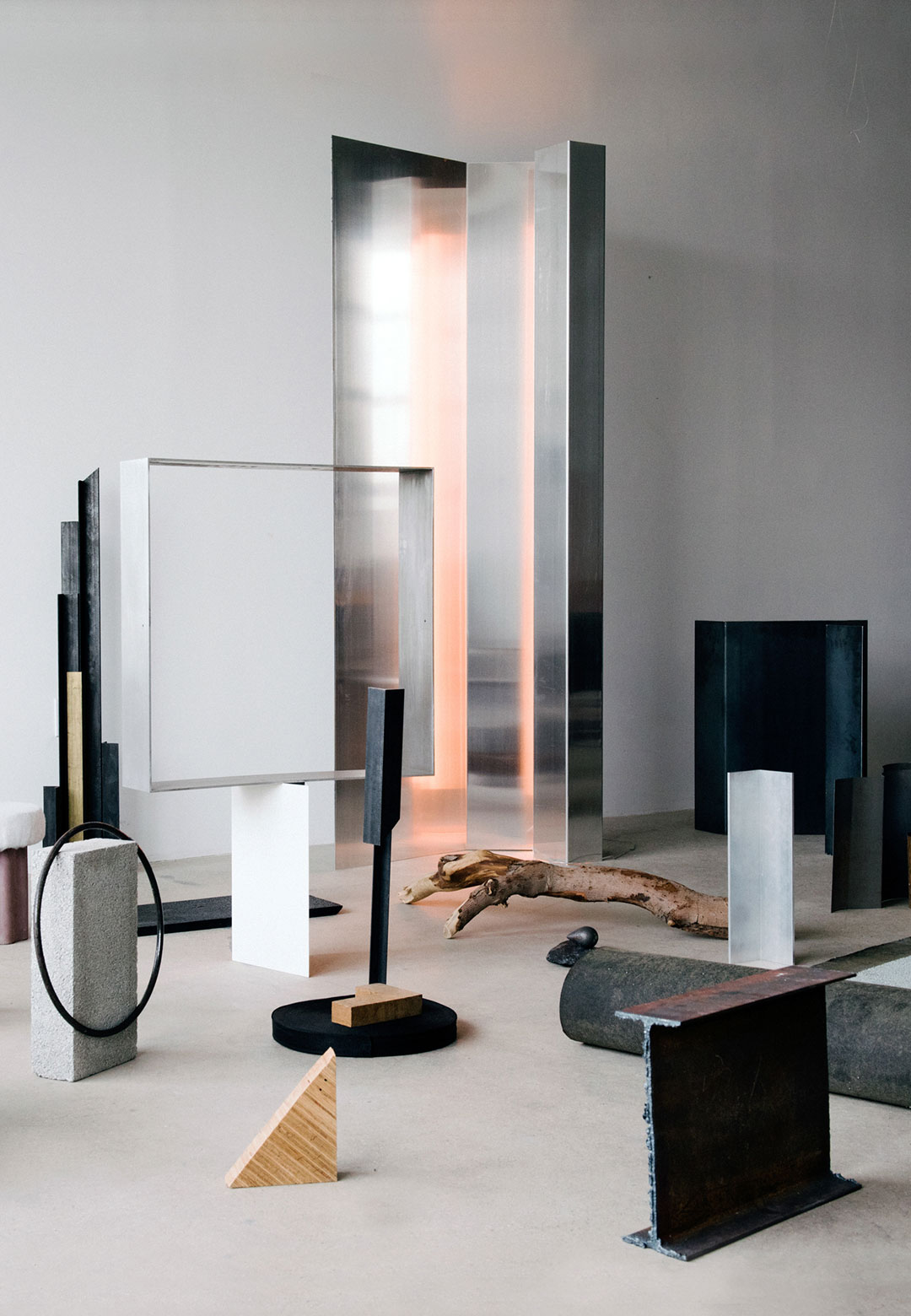"My studio in the Brooklyn Navy Yard overlooks the Manhattan skyline—with its dynamic elevations, industrial elements and linear grid naturally finding their way into my work," New York-based German-Italian architect, sculptor and designer, Umberto Bellardi Ricci, tells STIR. Bringing and transcribing the city to an interior scale by "embedding urban elements into the design—integrating metals like steel and aluminium with textiles or stone to create sculptural designs that reflect the geometry of architectural towers," he contrives a dialogue between the dynamism of urban design and the intimacy of interior spaces. Ricci's work, a striking mélange of sculptural furniture and lighting designs, offers an eloquent lexicon of contrasts, where industrial, towering silhouettes are etched into and scaled down to emblematic lines, curves and folds.
UBR Studio, the furniture designer's contemporary design practice founded in 2019, is deeply rooted in his multifaceted creative background, which also informs his contextual approach to design. With the precision of an architect and the imaginative flexibility of a sculptor, Ricci reconciles structure and form in his products. As he states, "Architecture has instilled in me an understanding of scale and proportion…The emphasis on structural integrity influences my work, as I often juxtapose architectural elements with delicate materials. While sculpture has sharpened my ability to reimagine forms, my experience as a teacher keeps encouraging me to question and expand my approach to design."
Ricci's sculptural furniture is earmarked in a principle he describes as "an interplay of scale, proportion and form, exploring the spatial aspect of sculpture through the lens of architecture." He converts raw industrial materials into minimal lamp designs, carved with delicate folds of brushed metal that cradle warm light like a guardian's hand. "The idea of a steel folding around the light is inspired by a hand holding a candle protecting it from wind," the project's press release mentions. Reminiscent of the angular majesty of Manhattan's skyline, where beams and shadows spell urban grandeur and nocturnal allure, his recent lighting pieces comprise the standing, leaning and floor brass Mano, Tavola table light, a series of wall scones and the aluminium Spira.
His approach to furniture fosters an intimate discourse between tactile materials and modelled forms. Ricci's table designs, for instance, emerge as monumental surfaces where the sumptuous warmth of bronze, travertine and marble softens the cold austerity of steel and I-beams. As described in the press release, each piece, "ranging from an amoebic feminine form of an evocative Luca and Andrea tables, followed by a further exploration of contrasts with Riso material varieties, to structural forms of a folded aluminium bases developed for Pica series", is a study in contrast, balancing robust, industrial legacies with fluid, organic shapes.
Beholding product designs and spaces as interconnected elements, UBR Studio's seating designs range from elegant, low platforms to softly contoured chairs, expressed through the contiguity of rich textiles and formal metals. "A gentle friction of rich bouclé and raw industrial steel of a low-lying platform Trave sofa, or soft pink Mohair against anodised aluminium in Chair C, charges this collection with a spacious complexity," the design team describes in an official statement. Likewise, the Trono series of ottomans procures an experiential environment where the upholstered seats by the French fabric and furnishing house, Pierre Frey and the Italian fabric house, Dedar, are juxtaposed with patinated black polished I-beams.
The evocative Zoccolo series analyses the suspension between permanence and impermanence. This collection of stacked sculptures, named after the Italian root for the plinth, is a delicate balance of organic and industrial surfaces. 'Ready-made' concrete building materials and modern elements such as stainless steel and vernacular wood are contrived into totems that challenge gravity and defy conventional construction. These etched, almost calligraphic arrangements, "from trapezoidal pier blocks to flat cinder blocks and scalloped garden pavers in shades of grey, sand and ochre red" resonate with Japanese wood joinery and the subtle minimalism of Romanian artist Constantin Brâncuşi's Endless Column, transforming derivative elements into a contemplation on subjectivity.
"The contrast in textures across the cityscape and the glass towers adjacent to historic stone façades inspires my exploration of pairing structural components with softer, more precious finishes," Ricci points out. His exploration begins with a series of experimental prototypes, "where each one [material] is selected not only for its inherent characteristics but also for how it enhances and amplifies the qualities of the others," the lighting designer continues. This iterative journey originates from his interest in dichotomies where materials such as sheet steel gain structural dimensionality through strategic folds and glass or marble provide a counterbalance of tactile refinement.
Driven by a pursuit to harmonise functionality with an architectonic aesthetic, Ricci orchestrates subtle contrasts in his designs, a tribute to urban landscapes and a compelling call to reconceptualise the space surrounding us through objects. With several large-scale commissioned pieces in the pipeline and a forthcoming design collection slated to debut at the end of the year, his vision and artistic sensibilities continue to evolve. "Our Brooklyn studio is expanding and I'm working on some exciting interior projects in DC, Long Island and New York that will be announced this fall," Ricci tells STIR.
- Brooklyn
- chair design
- contemporary artist
- contemporary design
- floor lamp
- furniture design
- furniture designer
- italian designer
- italy
- lamp design
- lighting design
- lighting designer
- new york
- product design
- Product Designer
- sculptor
- sculptural artist
- sculptural design
- sculpture art
- stainless steel
- Table design
- urban design






 Sign in with email
Sign in with email










What do you think?